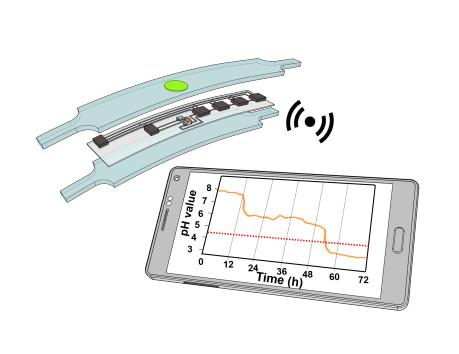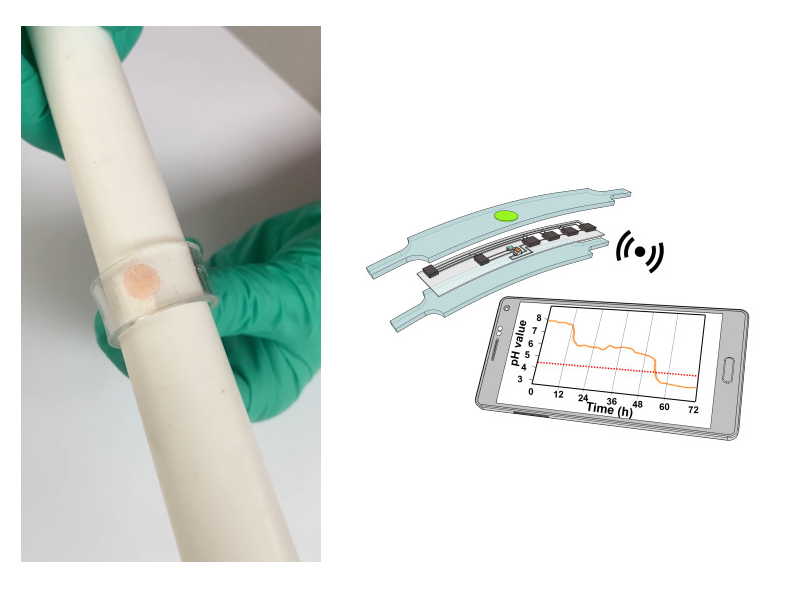The system consists of a biodegradable sensor and a wearable microelectronic system and was developed by the team of electronic engineers of the Department of Information Engineering of the University of Pisa. The study on Advanced Materials Technologies
A miniaturized pH detection system that transmits real-time data to a smartphone will allow substantial progress in the diagnosis and treatment of extremely widespread diseases, such as bacterial vaginosis, the diagnosis of which requires an accurate detection of tissue acidity, and which is often associated with complications that have a great impact on women's quality of life.

The study was published on Advanced Materials Technologies by the electronic engineering research group coordinated by Giuseppe Barillaro, who has been working for a long time on advanced sensors with applications in the biomedical field, in collaboration with the researchers of Surflay Nanotec GmbH, Germany. The Pisa-based research group together with the ab medica company is also planning the integration of the technology into wearable devices for advanced diagnoses.
“Last year - explains Barillaro, professor of electronics at the Department of Information Engineering of the University of Pisa (DII) - we developed an innovative sensor, the size and thickness of a postage stamp, totally biodegradable in body, and in capable of detecting the pH of tissues through a very simple fluorescence mechanism. When stimulated with green light, the sensor emits light in the red spectrum, with an intensity that corresponds to a pH value. (Read the news https://www.dii.unipi.it/news/news/un-sensore-bioriassorbibile-sottopelle-pu%C3%B2-monitorare-i-segnali-del-corpo). In recent months, as part of the European RESORB project funded by the European Innovation Council, we have taken a further step forward, developing a miniaturized optoelectronic system, which stimulates the sensor, detects the light emitted by it and sends the measured pH value to a smartphone wirelessly. The system, made up of the sensor and wireless electronics, can be applied, for example, to a flexible contraceptive vaginal ring, and monitor vaginal pH continuously and in real time, allowing the treatment of very common pathologies among women such as bacterial vaginosis”.

“The sensor can detect the pH for four consecutive days, and then it biodegrades completely in the body - adds Alessandro Paghi, researcher at DII and co-author of the study - while the ring with the miniaturized optoelectronic circuit, also containing the data acquisition system, a wireless transmitter and power batteries, can be reused with new sensors. System performance is excellent, allowing for continuous and accurate pH monitoring.”
"There are many potantial applications of a miniaturized and biocompatible wireless system for in situ analyzes - continues Martina Corsi, PhD student at DII and co-author of the study - , for the most diverse pathologies that require continuous monitoring of the acidity level of tissues, such as those on the gastrointestinal system, analysis of wounds or oncological pathologies, but also for even more complex analyses, in addition to pH detection, developing fluorescence sensors responding to different markers.”
The great potential of the developed technology to find use in various applications has led to an active collaboration of the research group with the Milanese company ab medica.
“The many years of scientific collaboration with the Department of Information Engineering of the University of Pisa and in particular with the team of Giuseppe Barillaro represents a virtuous example of collaboration between a public university of excellence and a company like ab medica which actively invests time and resources in Innovation. - explains Cosimo Puttilli, Research and Innovation Manager of ab medica - Specifically, our role concerned the creation and miniaturization of the receiver and transmitter external to the sensor, as well as the APP that allows you to view the data acquired by the sensor developed in Pisa.
The final goal will be to integrate the new technology into wearable or implantable devices that will allow the diagnosis of pathologies that are very widespread today, but are currently difficult to monitor".

